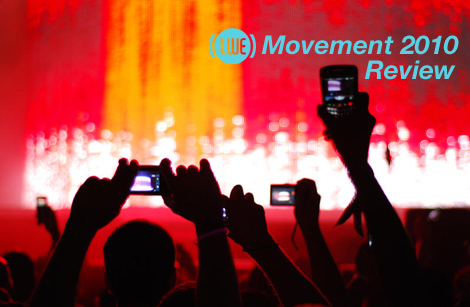
Photo by Elizabeth Beale
After resting his ears and brain cells, LWE’s editor-in-chief, Steve Mizek, files his report on Movement 2010
As May rolls around each year, many dance music fans in America and around the world instinctively reach for their wallets and begin making preparations for Detroit’s annual electronic music festival, Movement. Although the festival has gone through many iterations in its eleven years of existence, this habit proved equally entrenched in 2010 as fans of all ages and from every corner of dance music culture returned to the Motor City to visit with old friends, make new ones, and dance until their feet threw in the towel.
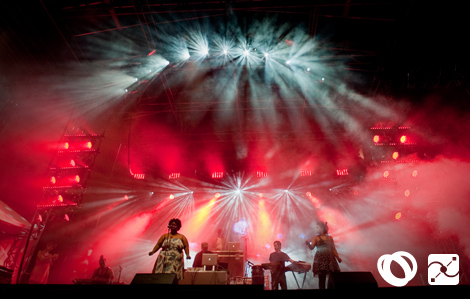
Inner City. Photo by Bryan Mitchell for Paxahau
Slung across Memorial Day weekend, set outside in Hart Plaza, and featuring a broad range of musical acts, Movement is closer to a Lollapalooza style of festival than the substantially more niche events that make up the Mutek and Unsound NY festivals. This approach has its advantages and drawbacks. On the positive side, an abundance of acts assures that attendees will have their tastes will be catered to — however briefly — and provided alternates in case of disappointments. The all-at-once style also puts a larger strain on the promoter’s resources, and spending in one area (eg. adding extra talent) can mean less for another (eg. no free water in the VIP section). If attendance numbers are any indication, this format has grown increasingly popular since Movement first became a paid event, attracting a record number of more than 95,000 ticket holders in 2010, according to The Detroit News. Overall I enjoyed my time at Movement, but I suspect some of the fest’s shortcomings were the result of the give and take required to cast its net so widely, so quickly.
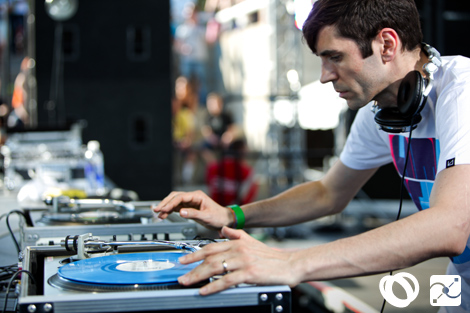
Martyn. Photo by Joe Gall for Paxahau
At first glance, Movement’s line up was spectacular, bringing together dozens of artists I’d long wanted to see, such as Ricardo Villalobos, Kyle Hall, Theo Parrish, Martyn, and many more. The reality was slightly less rosy, not least because visa issues caused Villalobos to cancel his long awaited appearance. Many of the artists I wanted to see were also clustered around the same times, leaving me dashing from stage to stage in hopes of at least sampling both Cassy and Anthony “Shake” Shakir, or dOP and DJ Koze. I was disappointed with the line-up for the Red Bull stage, which was occupied by drum and bass acts for the majority of Saturday with only a token artist to represent the burgeoning U.K. bass music scene — and few would argue Martyn even remotely fits that classification. There were a few other lame bookings as well (is Booka Shade still relevant in 2010?), but the biggest disappointment on this front was the Movement Torino stage.
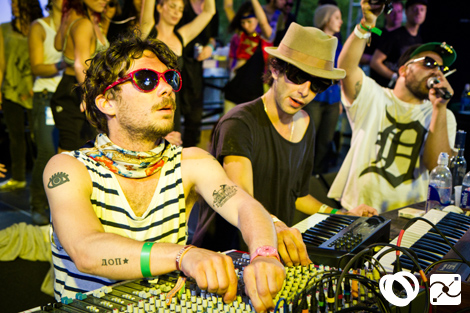
dOP. Photo by Paul Kelley for Paxahau
Inaugurated this year after Movement launched the Torino-based version of the fest in 2009, the Torino stage brought the total number to five and was comfortably positioned in a grassy area along Hart Plaza’s streetside perimeter. A long, nearly wall-less tent stacked full of speaker cabinets, the stage was looked upon with jealousy by those of us who spent much of the weekend in the tomb-like underground area hosting the Made In Detroit stage. Not only did the stage have a weak line-up, it was sparsely attended for long stretches of time when more desirable artists like Kirk Degiorgio were playing. Considering how full the Made In Detroit stage stayed throughout the fest, it seemed foolish to find it it once again relegated to an underground, concrete clad stage with poor acoustics. It’s a shame Paxahau, the promoters behind the festival, still hadn’t learned their lesson three years on.
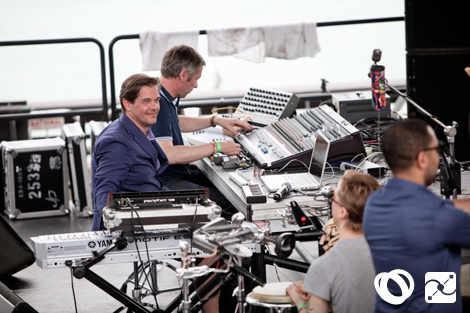
The Moritz Von Oswald Trio with Carl Craig. Photo by Joe Gall for Paxahau
Keeping five stages running simultaneously and smoothly throughout the festival requires a large, skilled crew to handle all sorts of problems. Sadly tech problems were not uncommon throughout the weekend; and while it’s presumptuous to attribute these to Movement’s expansive size it certainly didn’t help that five stages needed attention. Where strings of sound dampeners hung from the ceiling yielded modest gains in the sound quality of the Made In Detroit stage, various gear problems left artists playing at inconsistent volumes, through turntables emitting obnoxious feedback (as marred Kyle Hall’s set), and without sound at all (during Robert Hood’s live set). If not for the quick thinking and hard work of an unsung hero like producer/engineer Kevin Reynolds, the Made In Detroit stage would’ve been in shambles. Gear problems also took a large bite out of The Moritz Von Oswald Trio’s highly anticipated set and decimated their audience.
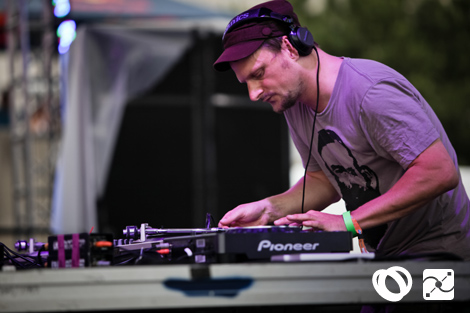
DJ Koze. Photo by Joe Gall for Paxahau
For many electronic artists, events aiming to please the broadest range of fest-goers means tapping into the most populist part of their sound. Unfortunately few DJs do this well; it’s as if there is a formula dictating that for every hundred dancers beyond the first the music needs to be more visceral and less challenging or detailed. For example, Chicago acid pioneer DJ Pierre peppered his set with unflattering minimal house cuts that forfeited the momentum of his better, more acidic selections (and hearing him play Dubfire’s remix of Radio Slave’s “Grindhouse” was enough to make me walk away). Although this phenomenon was most prevalent at the usually minimal-focused Beatport stage, it also affected artists like DJ Koze, Kirk Degiorgio and Onur Özer who I expected to throw off the shackles of lowest common denominator techno/house but ended up embracing it in order to attract and keep bigger audiences. DJs like The Martinez Brothers reveled in the inanity of their music, endlessly milking the entertainment value of dropping the bass on their exasperating facile Latin house tracks.
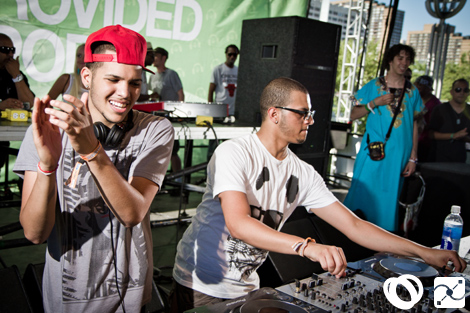
The Martinez Brothers. Photo by Paul Kelley for Paxahau
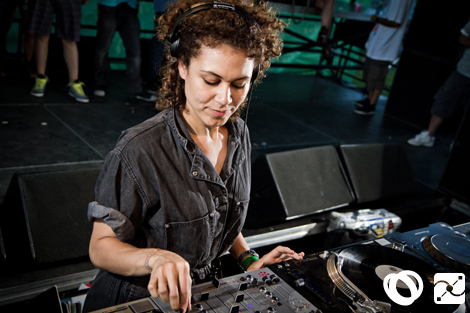
Cassy. Photo by Paul Kelley for Paxahau
Thankfully, there were also DJs who played to bigger crowds without sacrificing any quality from their selections. Cassy, who opted for the hardest tracks I’ve ever heard her play, was especially successful in this regard. She satisfied her audience with a mix of techno bangers (seemingly culled from minimal’s first, Detroit-based heyday) and effortless, summery house grooves without veering into dry patches. Larry Heard ran with the acid house vibe his predecessor, DJ Pierre, couldn’t reliably deliver and kept the concrete bowl of the main stage relatively full. Martyn, an artist whose appeal is defined by his ineffable nature, kept his set varied and thick with hooks and vocals. Whether he was playing 2-step, minimal techno, wobbly dubstep or classic house audience his audience never missed a beat, even launching into crowd surfing during Adonis’ “No Way Back.” Derrick Carter and Derrick May also deserve praise for their canny populism, tossing classics like Paperclip People’s “Throw” into their minimally-inclined but decidedly funkier house sets.
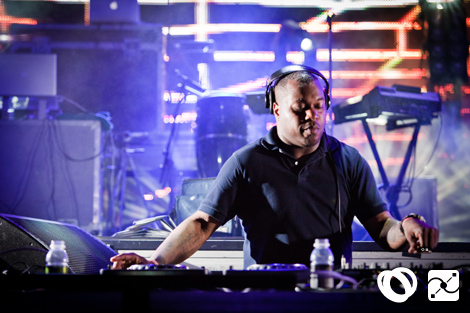
Derrick Carter. Photo by Douglas Wojciechowski for Paxahau
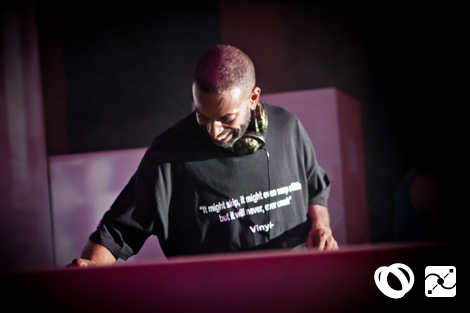
Theo Parrish. Photo by Aaron M. Jones for Paxahau
Yet my favorite sets came from artists who tried to lead their audiences or seemed completely uninterested in crowd expectations. Theo Parrish was the king of the latter domain, weeding out those who were there for anything but the music with loose, free jazz cuts before launching into an eclectic mix of contemporary R&B, proto-house, new wave, remixes of Marvin Gaye, and a few of his own tracks — including his LCD Soundsystem remix. His ability to be recondite but irrepressibly fun made his set worth waiting the extra hour while he readied himself off-stage. Rick Wilhite was also good at confounding and entertaining audiences with a set that had as much to do with rock as funk, dropping remixes of Bjork between unusual old house tracks with a regal air to his posture while at the decks.
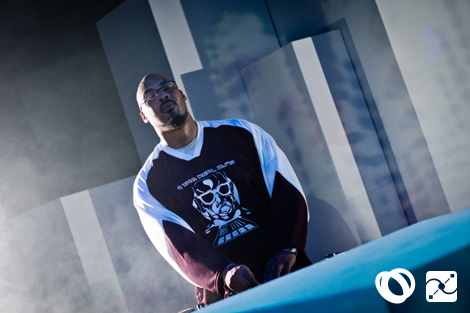
Rick Wilhite. Photo by Aaron M. Jones for Paxahau
Visibly frustrated but equally determined, Kyle Hall worked through a buzzing turntable to keep his dancers happy, finding common ground between jack tracks, old school classics like Cajmere’s “Brighter Days” (Underground Goodie Mix), and new, soon-to-be classics like Wax’s “No. 30003-A.” One of my most beloved moments of the entire festival arrived during a similarly diverse set from Anthony “Shake” Shakir, whose brusque transitions were made unimportant by his unexpected track selections. Those who doubted the dance floor potential of Kyle Hall’s “Kaychunk” were proven misinformed when Shake unleashed the cut to the delight of a packed Made In Detroit stage, dancers following along even through its beatless portions and throwing hands in the air when the kicks returned. I also enjoyed a deep and techy set by Patrice Scott of Sistrum Recordings and parts of the blistering techno churned out by DJ Rolando, an admired UR-affiliate.
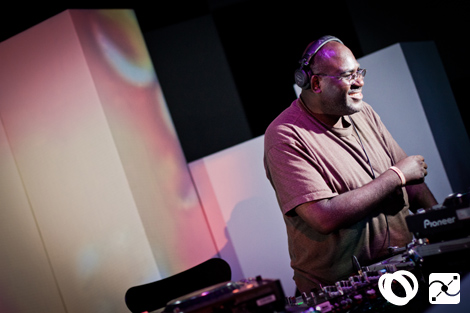
Anthony “Shake” Shakir. Photo by Aaron M. Jones for Paxahau
The live PA is an arena that usually allows artists to avoid giving in wholly to populism because they’re playing their own material. Yet the biggest pitfall of live PAs is how they magnify an artist’s aesthetic weaknesses and require consistently engaging music to keep the ball rolling. This was especially noticeable for Martin Buttrich, who drew largely upon his debut album with all its indistinct arrangements writ large over an hour’s time. Much to my surprise, dOP similarly struggled to keep fest-goers engaged. Oozing charisma, vocalist Jonathan Illel did his best to keep the crowd pepped up with goofy stage antics, but the set seemed canned and unusually insipid for a group as stylistically diverse as dOP. René Löwe and Peter Kuschnereit, the men charged with keeping Basic Channel’s music alive as Scion, had a hard time building momentum behind their feathered dub chords and drones. Fans of Richie Hawtin’s Plastikman material were understandably thrilled with his rare performance, but I found his shimmering LED display more interesting than his straightforward minimal techno.

Plastikman. Photo by Bryan Mitchell for Paxahau
Of course it wasn’t all bad on the live PA front. Ryan Crosson and Niko Marks were more engaging, the former because his psychedelic style kept shifting and the latter because he sang along and played keys with his prerecorded tracks. Despite the rain and lengthy gear troubles, The Moritz Von Oswald Trio, who were joined by Carl Craig, gave no quarter to accessibility and soldiered on through free jazzy arrangements and dub-flecked rhythms. Kevin Saunderson and Paris Gray’s Inner City project proved to be an entertaining if predictable headliner for Sunday night, performing the radio-ready tunes that brought them acclaim without renovating much for the 21st century. But the granddaddy of all live PA’s came from Robert Hood. Dressed in his signature jump suit and tweaking a bank of analog equipment, Hood built impossibly complex rhythmic structures higher and higher before demolishing them under the weight of truly gargantuan kickdrum hits. Even when his equipment suddenly gave out he was quick to find a solution and launched right back into destroying what remained of audience’s hearing.
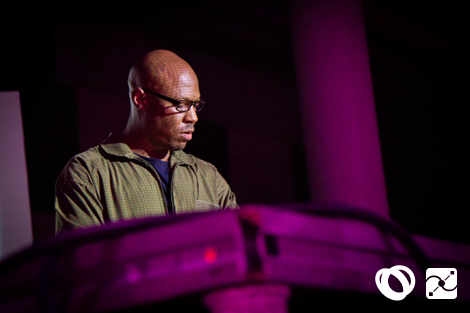
Robert Hood. Photo by Paul Kelley for Paxahau
The cure for the blandness of so many DJs’ festival sets was attending afterparties, which seemed to be held almost anywhere people could fit a PA. As we noted in our afterparty guide, there were so many going on it was impossible to attend everything you wanted without a car, superhuman stamina, and a fat stack of bills. But the parties I did attend offered such concentrated good times that I didn’t mind missing the Shit Show or the infamous boat party. The best party I attended was NDATL’s Deep Detroit at 1515 Broadway. Essentially the back room of a late night cafe, the space was perfect for hearing Kai Alce lay down some unconventional deep-house, one of the most perfect house sets I’ve ever enjoyed care of Larry Heard, and a James Brown-heavy set from Theo Parrish — not to mention the exclusive 7″ single on sale. That same night I tried to catch Ben Klock at the Centre Street Social but left disappointed as the long line I waited in was informed the party had been shut down by the police. This became a common theme throughout the weekend as the police shut down party after party, possibly in response to a number of shootings that reportedly occurred early Sunday morning. Early Monday morning I made it to the MetroPlex 25 party located in a gigantic building stocked with three floors of DJs. There I enjoyed an uniformly excellent house set from Eddie “Flashin” Fowlkes and a surprisingly decent and techy set by Kevin Saunderson, offering more evidence that the big stage mentality is only temporary.
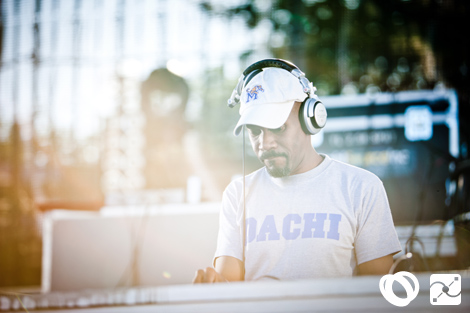
Larry Heard. Photo by Douglas Wojciechowski for Paxahau
As much as I’m glad that Movement is becoming a truly popular destination for electronic music fans of all stripes, I’m also disheartened by what that’s meant for the quality of the festival. Granted any large scale event is going to feature DJs playing to the sensibilities of unwashed masses, but Movement’s continual enlargement has escalated the rate at which I’ve been disappointed by jocks giving in to these instincts. The addition of a fifth stage yielded very little of interest and was another slap in the face to Detroit’s homegrown talent who were without a doubt the festival’s highlight — even in an unfavorable venue. Focusing on creating a catch-all electronic music festival to sell ever more tickets has come at the expense of the bedrock on which it was founded. What’s more, the quality of the afterparties schedule that weekend made it easier for fans to skip the festival entirely and catch sought after artists in settings conducive to the highest caliber of music instead of what might work for candy ravers, guys in green body suits, and average fest-goers alike. I sincerely hope Paxahau and all involved at Movement continue to refine what works and show more respect for Detroit’s artists instead of relentlessly expanding. It’s a wonderful festival that I’ve enjoyed a great deal each year — including this one — but the reasons for returning for the festival itself are dwindling.













Glad to see you are faster with your notes than I am! I would agree that the scheduling and locations seemed to be quite offhand. The Detroit and Torino stage should have switched, but I also have problems with the Beatport tent; namely, the sheer inaccessibility with the crowds and the poor lines of sight.
I would say that the sound quality at Detroit was actually an improvement over the last two years. The quality was bad enough that I couldn’t stay for more than 5 minutes at a time. There was a lot of bleeding of sound in between the stages; I could hear the Main Stage as clearly as I could the Beatport Stage when standing at the Beatport Stage. Didn’t help the atmosphere; heck, the only decent act I saw there was Cassy.
The main stage needed more consistency, especially on the first day. Ambient and dub segued nicely into Substance & Vainqueur, but Woody McBride’s 150 BPM acid techno? Better suited to the Red Bull Stage. Consistency wasn’t a problem with the Beatport stage, because every artist pretty much played the same thing.
Movement Torino stage? Seriously. As boring as the Beatport stage with +500 DB of volume.
Finally…No free water in the VIP stage? What, they expect you to sate yourself with free/discounted booze? On a hot day? Do the math…
The lack of free water almost certainly contributed to Kirk Degiorgio needing medical attention for dehydration. That’s an unacceptable way to handle talent.
That was an interesting read. I’m curious, did LWE have anyone covering Mutek? I was there for most of it and, while I’m not a seasoned dance music vet or anything like that, I felt like it was largely free of the problems you describe at Movement. Guys like DJ Koze and Move D played very adventurous and musically rich sets that the crowd seemed to really enjoy.
I was in the VIP area all weekend. There were literally thousands of bottles of Smart and Vitamin Water readily available for the entirety of the festival up until the literal last half hour. Seems like a gross exaggeration of the conditions, or like someone did not actually check out the VIP section…
Both were certainly available — at the bar, for a price — but nowhere did I see the big tubs of free bottles like there were in previous years. I don’t know where in VIP you lounged (and I’m not speaking of the indoor artists area, where it might’ve been free), but it certainly wasn’t out in the open as in the past.
@ML
Our own Steve Kerr is reviewing the festival. Watch for his review in the coming days.
Hi Steve
was nice to meet you at Movement.
Just wanted to say, the dehydration was entirely my fault, water was freely available for me, but I got carried away with my set and didn’t drink enough. I was pretty much out in the sun the entire day, so the combination got me into a little trouble. Thankfully it was minor and everyone had a good laugh at my expense 😉
KD
Thanks for chiming in, Kirk. Good to meet you too!
Good article. Have to say I thought the sound was pretty good in the Underground Stage, no real complaints about it apart from some hiccups.
No mention either of my two highlights of the entire weekend of the Fest (along with Rob Hood)? Kenny Larkin followed by Model 500, both outstanding. Maybe you didn’t witness it but both were special.
That 1515 Broadway party was certainly off the hook, nice to see Theo twice in one night too, doing two completely different sets.
complain complain complain! can you do better is the question? if not consider the amount of blood sweat and tears that goes into an event that has almost none of the sponsorship most festivals get in europe,brazil, japan,,keep in mind there is no sponsor at the front door of Movement with a blank check book,and there most likely never will be,,its a hustle every year to make this thing work in a city that has a 500million dollar debt..yea things go wrong, but at the end of the day theres only 2 or 3 festivals in all of the USA that are even worth a rats ass….so how about you all slack up a bit cause if Movement was to be done today,, everybody would say “damn i really miss that festival in Detroit””i really miss going to Detroit…something is better than nothing,,unless of course you can do better!
Hey Derrick, I’m honored you took the time to read my review. I would like to think it was more constructive than a list of complaints, but that’s me.
I think a more useful question than “can you do better” (as no one is likely to task me with putting on a festival) is, what can be done differently to make Movement better? As much as I sympathize with Movement for its relative lack of sponsorships (overlooking a central one from Ford), I believe that only strengthens the argument for making tough, smart choices about the festival’s shape in coming years. Here are a few of my ideas on the matter:
– Despite Movement’s ties with its new sister festival in Torino, the Torino stage seems like an overreach and not the best use of Hart Plaza’s space. With four stages pumping almost the entire weekend it seems like an expensive extra that doesn’t have the pull of other stages (I would be surprised if anyone made the decision to attend based on its line up).
– The Made In Detroit stage is hugely popular but is stuck with a frustrating (if gradually improving) venue. If the Torino stage were nixed MID could easily occupy that space, which I’m sure would delight both the artists and attendees. If Torino is a must, it and the MID stage should rotate positions annually so it doesn’t seem like the most Detroit-focused line up is continually getting shafted.
– Mix up the scheduling a bit. One obvious reason so few show up before the late afternoon is because sought after artists are all scheduled later in the day, and often all at the same time. Traditionally it made sense to use these arrangements as they provide some sense of pecking order, but it forces fest-goers to catch only portions of sets by the artists they most want to see. Anthony “Shake” Shakir would sound as good at 2pm as 7pm and it would free up his audience to see other artists later. I’ll admit, this is the most pipe-dreamy of my recommendations, but I imagine it could make for a better, more consistent festival experience.
Of course, some things just can’t be prevented: the curse of playing to huge crowds, the occasional gear problems, these plague most festivals of Movement’s size and scope. And I would certainly never advocate doing away with the festival or just not attending — I’ve have a good time each year, warts and all. But if we can’t brainstorm how to improve the festival instead of just cutting it slack for being uniquely positioned and short on sponsorships, all the blood, sweat and tears sunk into Movement is truly being underappreciated. I applaud Paxahau and all those involved for what they’ve done well and encourage them to continue refining what works rather than finding ways to expand it.
“something is better than nothing”
i disagree.
Care to expand on that, Tom?
and seriously, you wanna know how to do a lineup for a festival like this? where are these artists?
Jus-Ed
Omar-S
Fred P
Pepe Braddock
Soulphiction
Lowtec
Metro Area
DJ Harvey
Tribe (i mean, carl was supposed to be involved this year, right?)
Shawn Rudiman
Convextion
$tinkworx
Blondes
Red D
San Soda
Arne Weinberg
Floating Points
Dam-Funk
James Pants
Kai Alce
Specter
Burial
Scott Ferguson
Juju & Jordash
Reggie Dokes
Waajeed/Platinum Pied Pipers
Hercules & Love Affair
Seiji
Moonstarr
Titonton
Todd Sines
Soundhack
Donato Dozzy
Tevo Howard
Rahaan
Jamal Moss
Basic Soul Unit
James Duncan
Hanna
Still Going
Newworldaquarium
Tiombe Lockhart
Karizma
Donnie
Grace Jones
MAURICE FULTON
Dimitri from Paris
Fertile Ground
Ican
Scott Grooves
Abicah Soul
Danny Krivit
Ta’raach
Thom Yorke
Jose James
Stacey Epps
Billy Love
Kenny Dope
Jazzanova
Amp Fiddler
Franck Roger
DJ Deep
Tony Humphries
and really, i can keep going and going and going!! the point is, this festival is put together by people who seem to have no fucking clue what is actually going on in the world of music. there’s all kinds of levels of artists in there, from underground to very popular. you could do SO MUCH MORE than what has been happening. they are turning DEMF into a rave. if you want to defend that, Derrick (if that is actually you), then you are a sucker. i hope you love that money you get paid.
@pipecock
A lot of the artists that you just mentioned have played at previous Movements, in the earlier years. At least from what I have gathered, the lineups and vibe was a lot more experimental and wide-ranging in the early days when it was free and less sponsor-centric (artists like George Clinton, The Roots, Mos Def, J Dilla tribute…non of whom would be considered electronic).
However, I understand what you mean by becoming more rave-centric, and I’m thinking corporate sponsors are more willing to bank on sponsoring events that have artists/genres with more commercial potential and public exposure (Deadmau5 in ’08, for example, or the trance/prog/electro centered events in the Pioneer/Torino stages in ’09/’10). When I first attended the festival in 2007, the lineup was noticably more organic and house-centered (Charles Webster, King Britt, Moodymann playing main stage, etc.)
of that list, maybe 20% have played the festival; the rest have not. of course having played the festival doesn’t stop Richie Hawtin (who still isn’t a Detroit native, BTW) from playing just about every year. many of these acts play other festivals and shows around the world with corporate sponsorship. what it boils down to for me is that if you’re catering to morons and corporate sponsors, that really isn’t better than just not having the festival. make it be something good, or give it up. or at least be honest about just making it a rave!
Agree with Derrick, and Pax needs to be applauded for stabilizing DEMF, especially now. However, the fest does lack Craig’s and May’s artistic vision and feel for independent art and artists in Detroit. Recently it merely hints at the essence of Detroit artists. A reflection of electronic music now ?? a promoters vision, not an artists ?? Maybe I’m bias ?? For me, it just seems to be served cold with a light touch of the warm soul of Detroit. But that warm soul will always draw me there year after year
Yes the review does come across as quite negative, and in the LWE style of too much thinking and not enough enjoying. If you don’t like an act at a festival you there’s plenty of options. And who cares if they’re “relevant”, whatever that means. Do you like them or not? That’s what counts.
Fair enough though if that’s your thing.
@ Andy T
You say that is if I didn’t enjoy parts of the festival because I was thinking about them instead of the reality: there were points I didn’t enjoy and this review contains my thoughts about them. If you went to a gig and were not enjoying it, would you blame that on thinking too much or the music? The whole purpose of the review was to articulate my levels of enjoyment.
Relevance plays a part in this: Booka Shade’s heyday was 2006-7 and they’ve not done much interesting since. Yet they’ve played the festival multiple times; why book them again almost five years after they’ve peaked when there are so many artists who are important and worth seeing in 2010?
Shame on LWE for putting thought into its reviews!
I had a lot of fun this year at the festival, but that honestly was despite the music and not because of it. Certainly there were some standouts, but I have to say I agree entirely with the reviewer about the Made In Detroit stage having some of the best talent of the weekend, while being stuffed down into that humid, sweaty, smelly, echoing HOLE of a stage.
I also found myself very frustrated with the amount of DJs that played to the lowest common denominator, throw your hands in the air, MTV Spring Break vibe all weekend (I’m especially looking at you, Beatport stage). I realize that a certain amount of detail gets lost in a venue/crowd that big, but at least put some effort into it and don’t be a lazy ass.
And I do have to agree with one of the other commenters about the talent that is out there right now. I have repeatedly lamented Paxahau’s seeming ignorance of the techno/dubstep crossover that’s been going on right under their noses for about 4 years now. Artists like 2562, Peverelist, Ramadanman, F, Headhunter…hey at least they grabbed Martyn, right? And while it was cool to see the hat at least tipped to the dubstep sound, they settled mostly for the North American meatgrinder noise, instead of spreading it out a bit and digging deeper for something more interesting.
But really, that’s symptomatic of the larger issue, and that the reviewer nailed. The fest is getting BIGGER, but is it getting better? Soundwise, yes. Best sound at fest ever. But with a few notable exceptions, it’s becoming more homogenized and ravey. Sorry, but when I get shoved away from the speaker where I am listening to an artist I have been following for a decade, and the one doing the shoving is some shirtless, tanned fratboy spilling his tallboy of overpriced Miller Lite all over me in the process…well…something has been lost.
I leave it up to you to extrapolate on what exactly that might be.
[…] This post was mentioned on Twitter by complicit music, complicit music. complicit music said: #TechnoPodcast LWE’s Movement 2010 Review – As May rolls around each year, many dance music fans in America and aro… http://ow.ly/17G1VY […]
[…] Little White Earbuds […]